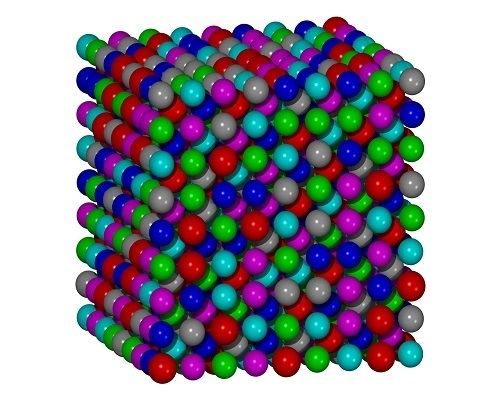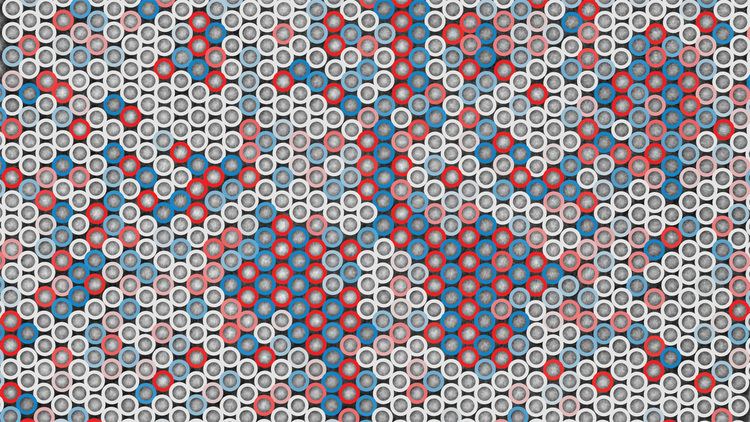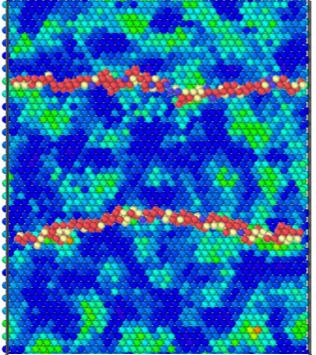 | ||
Multicomponent and high entropy alloys professor brian cantor
High-entropy alloys (HEAs) are substances that are constructed with equal or nearly equal quantities of five or more metals. These alloys are currently the focus of significant attention in materials science and engineering because they have potentially desirable properties. Prior to the existence of these substances, alloys consisted of only one or two base metals. For example, additional elements can be added to iron to improve its properties, thereby creating an iron based alloy. Hence, high entropy alloys are a novel material.
Contents
- Multicomponent and high entropy alloys professor brian cantor
- Early development
- Definition
- Alloy design
- Phase formation
- Thermodynamic mechanisms
- Kinetic mechanisms
- Other properties
- Synthesis
- Modeling and simulation
- Mechanical
- Electrical and magnetic
- Other
- References

Furthermore, research indicates that some HEAs have considerably better strength-to-weight ratios, with a higher degree of fracture resistance, tensile strength, as well as corrosion and oxidation resistance than conventional alloys. Although HEAs have existed since before 2004, research substantially accelerated in the 2010s.

Early development

Although HEAs were described as early as 1981 and 1996, significant research interest did not develop until after independent 2004 papers by Jien-Wei Yeh and Brian Cantor, with Yeh's first paper on the topic published 2 months sooner. Yeh also coined the term "high-entropy alloy" when he attributed the high configurational entropy as the mechanism stabilizing the solid solution phase. Cantor, not knowing of Yeh's work, did not describe his alloy as a "high-entropy" alloy, but the base alloy he developed, equiatomic FeCrMnNiCo, has been the subject of considerable work in the field.

Before the classification of high entropy alloys and multi-component systems, nuclear science had highlighted a system that can now be classified a high entropy alloy: within nuclear fuels Mo-Pd-Rh-Ru-Tc particles form at grain boundaries and at fission gas bubbles. Understanding the behavior of these '5 metal particles' was of specific interest to the medical industry as Tc-99m is an important medical imaging isotope.
Definition

There is no universally agreed-upon definition of a HEA. Yeh originally defined HEAs as alloys containing at least 5 elements with concentrations between 5 and 35 atomic percent. Later research however, suggested that this definition could be expanded. Otto et al. suggested that only alloys that form a solid solution with no intermetallic phases should be considered true high-entropy alloys, as the formation of ordered phases decreases the entropy of the system. Some authors have described 4-component alloys as high-entropy alloys while others have suggested that alloys meeting the other requirements of HEAs, but with only 2–4 elements or a mixing entropy between R and 1.5R should be considered "medium-entropy" alloys.
Alloy design
In conventional alloy design, one primary element such as iron, copper, or aluminum is chosen for its properties. Then, small amounts of additional elements are added to improve or add properties. Even among binary alloy systems, there are few common cases of both elements being used in nearly-equal proportions such as Pb-Sn solders. Therefore, much is known from experimental results about phases near the edges of binary phase diagrams and the corners of ternary phase diagrams and much less is known about phases near the centers. In higher-order (4+ components) systems that cannot be easily represented on a 2-dimensional phase diagram, virtually nothing is known.
Phase formation
Gibbs' phase rule,
The Hume-Rothery rules have historically been applied to determine whether a mixture will form a solid solution. Research into high-entropy alloys has found that in multi-component systems, these rules tend to be relaxed slightly. In particular, the rule that solvent and solute elements must have the same crystal structure does not seem to apply, as Fe, Ni, Cr, Co, and Mn have 4 different crystal structures as pure elements (and when the elements are present in equal concentrations, there can be no meaningful distinction between "solvent" and "solute" elements).
Thermodynamic mechanisms
The multi-component alloys Yeh developed also consisted mostly or entirely of solid solution phases, contrary to what had been expected from earlier work in multi-component systems, primarily in the field of metallic glasses. Yeh attributed this result to the high configurational, or mixing, entropy of a random solid solution containing numerous elements. Because
where R is the ideal gas constant, N is the number of components, and ci is the atomic fraction of component i. From this it can be seen that alloys in which the components are present in equal proportions will have the highest entropy, and adding additional elements will increase the entropy. A 5 component, equiatomic alloy will have a mixing entropy of 1.61R.
However entropy alone is not sufficient to stabilize the solid solution phase in every system. The enthalpy of mixing (ΔH), must also be taken into account. This can be calculated using:
where
Both of the thermodynamic parameters can be combined into a single, unitless parameter Ω:
where Tm is the average melting point of the elements in the alloy. Ω should be greater than or equal to 1.1 to promote solid solution development.
Kinetic mechanisms
The atomic radii of the components must also be similar in order to form a solid solution. Zhang et al. proposed a parameter δ representing the difference in atomic radii:
where ri is the atomic radius of element i and
Other properties
For those alloys that do form solid solutions, an additional empirical parameter has been proposed to predict the crystal structure that will form. If the average valence electron concentration (VEC) of the alloy is ≥8, the alloy will form a face-centered cubic (fcc) lattice. If the average VEC is <6.87, it will form a body-centered cubic (bcc) lattice. For values in between, it will form a mixture of fcc and bcc. VEC has also been used to predict the formation of σ-phase intermetallics (which are generally brittle and undesirable) in chromium and vanadium-containing HEAs.
Synthesis
High-entropy alloys are mostly produced using distinct methods that depend on the initial phase - starting either from a liquid, solid, or gas state.
Other HEAs have been produced by thermal spray, laser cladding, and electrodeposition.
Modeling and simulation
The atomic-scale complexity presents additional challenges to computational modelling of high-entropy alloys. Thermodynamic modelling using the CALPHAD method requires extrapolating from binary and ternary systems. Most commercial thermodynamic databases are designed for, and may only be valid for, alloys consisting primarily of a single element. Thus, they require experimental verification or additional ab initio calculations such as density functional theory (DFT). However, DFT modeling of complex, random alloys has its own challenges, as the method requires defining a fixed-size cell, which can introduce non-random periodicity. This is commonly overcome using the method of "special quasirandom structures," designed to most closely approximate the radial distribution function of a random system, combined with the Vienna Ab-initio Simulation Package. Using this method, it has been shown that results of a 4-component equiatomic alloy begins to converge with a cell as small as 24 atoms. The exact muffin-tin orbital method with the coherent potential approximation has also been employed to model HEAs. Other techniques include the 'multiple randomly populated supercell' approach, which better describes the random population of a true solid solution (although is far more computationally demanding). This method has also been used to model glassy/amorphous (including bulk metallic glasses) systems without a crystal lattice.
Further, modeling techniques are being used to suggest new HEAs for targeted applications. The use of modeling techniques in this 'combinatorial explosion' is necessary for targeted and rapid HEA discovery and application.
Simulations have highlighted the preference for local ordering in some high entropy alloys and, when the enthalpies of formation are combined with terms for configurational entropy, transition temperatures between order and disorder can be estimated. - allowing one to understand when effects like age hardening and degradation of an alloy's mechanical properties may be an issue.
Mechanical
The crystal structure of HEAs has been found to be the dominant factor in determining the mechanical properties. bcc HEAs typically have high yield strength and low ductility and vice versa for fcc HEAs. Some alloys have been particularly noted for their exceptional mechanical properties. A refractory alloy, VNbMoTaW maintains a high yield strength (>600 MPa (87 ksi)) even at a temperature of 1,400 °C (2,550 °F), significantly outperforming conventional superalloys such as Inconel 718. However, room temperature ductility is poor, less is known about other important high temperature properties such as creep resistance, and the density of the alloy is higher than conventional nickel-based superalloys.
CoCrFeMnNi has been found to have exceptional low-temperature mechanical properties and high fracture toughness, with both ductility and yield strength increasing as the test temperature was reduced from room temperature to 77 K (−321.1 °F). This was attributed to the onset of nanoscale twin boundary formation, an additional deformation mechanism that was not in effect at higher temperatures. As such, it may have applications as a structural material in low-temperature applications or, because of its high toughness, as an energy-absorbing material. However, later research showed that lower-entropy alloys with fewer elements or non-equiatomic compositions may have higher strength or higher toughness. No ductile to brittle transition was observed in the bcc AlCoCrFeNi alloy in tests as low as 77 K.
Al0.5CoCrCuFeNi was found to have a high fatigue life and endurance limit, possibly exceeding some conventional steel and titanium alloys. But there was significant variability in the results, suggesting the material is very sensitve to defects introduced during manufacturing such as aluminum oxide particles and microcracks.
A single-phase nanocrystalline Al20Li20Mg10Sc20Ti30 alloy was developed with a density of 2.67 g cm−3 and microhardness of 4.9 – 5.8 GPa, which would give it an estimated strength-to-weight ratio comparable to ceramic materials such as silicon carbide, though the high cost of scandium limits the possible uses.
Rather than bulk HEAs, small-scale HEA samples (e.g. NbTaMoW micro-pillars) exhibit extraordinarily high yield strengths of 4-10 GPa —one order of magnitude higher than that of its bulk form—and their ductility is considerably improved. Additionally, such HEA films show substantially enhanced stability for high-temperature, long-duration conditions (at 1,100 °C for 3 days). Small-scale HEAs combining these properties represent a new class of materials in small-dimension devices potentially for high-stress and high-temperature applications.
Electrical and magnetic
CoCrCuFeNi is an fcc alloy that was found to be paramagnetic. But upon adding titanium, it forms a complex microstructure consisting of fcc solid solution, amorphous regions and nanoparticles of Laves phase, resulting in superparamagnetic behavior. High magnetic coercivity has been measured in a BiFeCoNiMn alloy
Other
The high concentrations of multiple elements leads to slow diffusion. The activation energy for diffusion was found to be higher for several elements in CoCrFeMnNi than in pure metals and stainless steels, leading to lower diffusion coefficients. Some equiatomic multicomponent alloys have also been reported to show good resistance to damage by energetic radiation .
